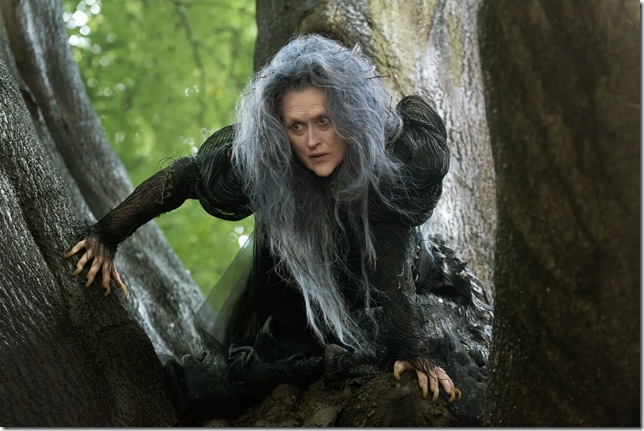I have the regret or the pleasure, depending on where you’re coming from, to admit that I’ve never seen Stephen Sondheim’s Into the Woods onstage. It’s a regret because it’s a grievous blind spot for any theater critic, but it’s a pleasure because I can view Rob Marshall’s film adaptation with the fresh eyes of discovery — and without the burden of screaming blasphemy! at the director’s every deviation from the source.
So, as a film at least — not necessarily as an adaptation — Into the Woods is enormously entertaining, a long time coming that will almost surely be worth it for critics and the masses alike. It is at first playfully witty, then subversively existential, and ultimately crushing in its final-act veracity. The musical’s first and second halves are so tonally different that an intermission seems conspicuously absent from the film; the movie flows like a pleasant river that is suddenly upset by an unrelenting tidal wave. Both are transportive and gripping for different reasons.
Marshall, who never met a camera edit he didn’t like in his shallow, misbegotten renderings of Chicago and Nine, has discovered in Sondheim’s musical tapestry a more appropriate source for his incessant slicing and dicing of reality, particularly in the show’s delirious opening number, the 15-minute “Into the Woods Prologue.” In this inventive example of fairy tale mixology, four stories converge in the titular forest.
The scullery waif Cinderella (Anna Kendrick, who can’t help but look fetching even when she isn’t supposed to) runs to visit a tree containing her mother’s spirit, which produces for her a ravishing ballroom ensemble; Little Red Riding Hood (Lilla Crawford) skips naively toward her grandmother’s treehouse, a theatrical Wolf (Johnny Depp) scheming in the wings; Jack (Daniel Huttlestone) crosses the woods to sell his favorite cow and winds up with — you guessed it — some magic beans; and a baker and his wife (James Corden and Emily Blunt, whose infectious chemistry grounds the movie) embark on a scavenger hunt to appease The Witch (Meryl Streep), whose century-old curse on the baker’s family has left them infertile.
Whether or not one of this film’s target audiences — children — will be able to follow all of this plot, let alone Sondheim’s atypical phrasing and sophisticated lyrics, remains to be seen. But adults will find it ravishing — bravura, even. Marshall’s fast cutting finally seems justified as we ping-pong between the narratives, exploiting the visual medium of film in ways that could never be accomplished onstage. In the process he cosmically links these four seemingly disparate stories until they finally fuse together in unwitting harmony.
Elsewhere, too, Marshall expands the story’s visual possibilities. He literalizes Red Riding Hood’s descent into the Wolf’s cavernous gullet, an icky thrill ride that ends with a surprise meeting with her grandmother, aka the beast’s previous meal. She’s still intact, waiting for the Baker to slice open the Wolf’s belly and rescue them both.
This makes little logical sense. Depp’s Wolf — who looks like a carnival huckster in a ‘30s movie, outfitted in lupine couture — is the same size as everybody else. There is no sense of scale and proportionality to any of this, which makes this adventure all the more unpredictable. In the first half, the woods are an intoxicatingly metaphysical place of kinetic connections and pure imagination where dramatic plot points can be eschewed with the wave of a hand, where achievements can be quickly negated, where everything is transient and nothing is permanent. They, and the movie, thrive on the magic of the impossible.
And then some viewers may look at their watches, because it appears everything is resolved an hour into the film. The genius of Sondheim and James Lapine, who adapted the screenplay from his own Broadway book, is that it doesn’t end on the storybook conclusion. The rest of the movie is set after the ever-after, as a giant, loosed from an errant magical beanstalk, terrorizes the community and sends everyone into upheavals both physical and emotional. There are disappointed expectations, insecurities and infidelities. And this time, the deaths are real, the destruction unchangeable.
The film’s halves reside on opposite poles, but what remains consistent are the songs, many of which, in typical Sondheim fashion, breeze through the characters’ psyches like gusts of wind and fade away just as quickly. But none are superfluous or tangential. The longer numbers are vehicles for self-discovery, sung by characters who, by the end of the tune, have sorted out life-changing dilemmas or revealed repressed motivations.
One of these is performed by Streep’s Witch; it’s aimed at her daughter Rapunzel, but it exposes her own toxic overprotectiveness. (Mackenzie Mauzy plays the long-haired damsel, who gets shorter shrift in the film than her fairy tale colleagues). From her first moment onscreen, Streep is an unforgettable fright, with her scraggly blue hair, rotten teeth and Cryptkeeper fingernails, her ostensible scariness undercut by a performance that is campy, tipsy and freewheeling. But in this moment, thanks to Streep being Streep, we can peer past this veneer of makeup and affect and penetrate the character’s soul. You can tell that Marshall is transfixed, too: Even he doesn’t cut away from her.
INTO THE WOODS. Director: Rob Marshall; Cast: Emily Blunt, James Corden, Anna Kendrick, Meryl Streep, Chris Pine, Johnny Depp, Mackenzie Mauzy, Tracey Ullman, Daniel Huttlestone, Lilla Crawford, Christine Baranski, Billy Magnussen; Distributor: Walt Disney Pictures; Rating: PG-13; Opens: Christmas Day at most area theaters
